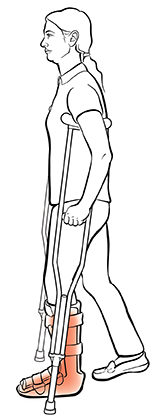Crutch adjustment
Make sure the crutches you use are adjusted to fit you. When you stand, there should be room to fit 2 or 3 fingers (about 1 to 2 inches) between the top of the crutch and your armpit. This will prevent pressure on the nerve. Your elbow should be slightly bent when holding the hand grips. When your arms hang down, the crutch handle should be at the top of your hip.
Crutch walking
Place the crutches forward about 1 foot in front of you. The crutches should be a little farther apart than your body. Lean your weight forward as you push down on the hand grips. Make sure your weight is on your hands and your strong leg, not your armpits. Let your body swing forward, landing on the strong leg. Move the crutches forward again. The crutch and your injured leg should move together.
Going up steps without handrails
Lead with the strong leg:
-
Keep the tops of the crutches under your armpits. Put the bottom of both crutches on the same step as your feet. Push down on the hand grips.
-
Balancing with very light pressure on the weak leg, let your hands support your weight. Raise your strong leg onto the next higher step.
-
Keep your strong leg bent and transfer all your weight to it. Move the crutches up to the step, next to your strong leg.
-
Keep your weight evenly balanced on the 2 crutches and your strong leg. Straighten your strong knee as you raise your weak leg up to the next step.
Going down steps without handrails
Lead with the weak leg:
-
Keep the top of the crutches under your armpits. With both crutches on the same step as your feet, push down on the hand grips.
-
Keep your weight evenly balanced on the 2 crutches and your strong leg. Bend your strong knee as you lower both crutches to the next step.
-
Keep your strong leg bent and let it support you as you move the crutches down next to the weak leg.
-
Transfer your weight to your hands. Balance with very light pressure on your weak leg as you lower your strong leg next to your weak leg.
Going up steps with handrails
Lead with the strong leg:
-
Face the stairs, holding the handrail with one hand. Place both crutches under your armpit on the opposite side. Push down on the hand grips.
-
Balancing with very light pressure on the weak leg, let your hands support your weight. Raise your strong leg onto the next higher step.
-
Transfer all your weight to your strong, bent leg as you move the crutches up (while holding on to the handrail) to the next step next to the strong leg.
-
Keep your weight evenly balanced on the handrail, the crutches (still under the same armpit opposite the handrail), and your strong leg. Straighten your strong knee as you raise the weak leg up to the next step.
Going down steps with handrails
Lead with the weak leg:
-
Face the stairs, holding the handrail with one hand. Place both crutches under your armpit on the opposite side. Push down on the hand grips.
-
Balance your weight evenly on the crutches, handrail, and your strong leg. Then bend your strong knee as you move the crutches down to the next step.
-
Let the handrail and your strong, bent leg support you as you lower the weak leg down next to the crutches.
-
While holding on to the handrail and crutches (under the same armpit on the other side), transfer your weight to your hands, balancing with very light pressure on the weak leg as you lower your strong leg alongside your weak leg.
Tip: If you're worried about falling or you feel unsteady, try sitting when going up or down stairs. Sit on the bottom step and keep your injured leg out in front of you. Hold your crutches flat against the stairs. Then slide up to the next step on your bottom. Use your free hand and good leg for support. Face the same way when going down stairs.


